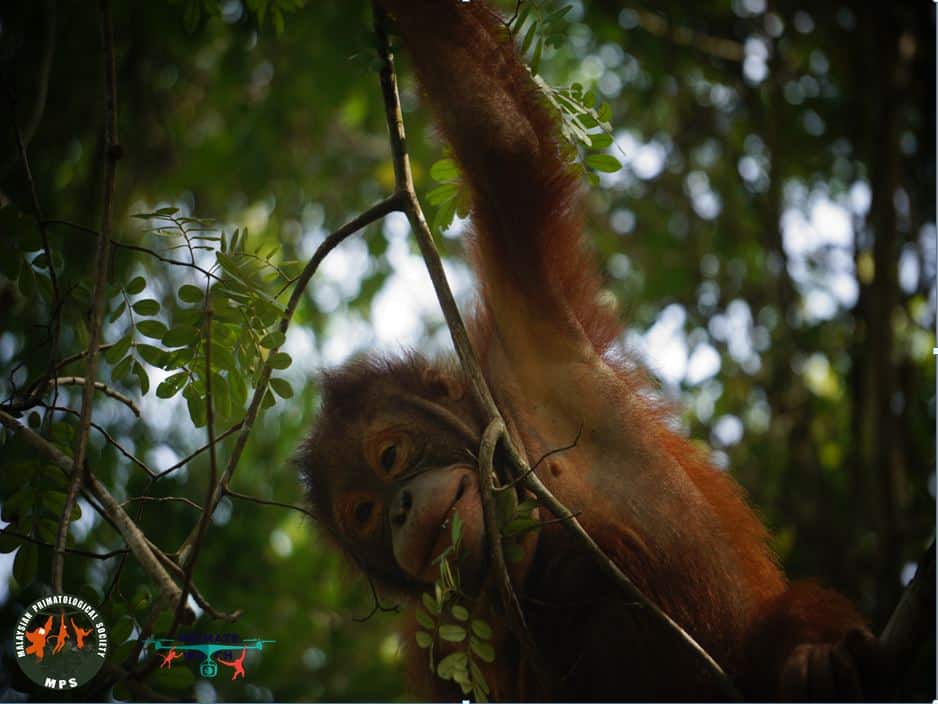I tend to forget names, especially when I meet new people. For instance, there was this man visiting my study site one morning. He was in Sarawak for a brief period and was involved in a tiger conservation meeting (if I’m not mistaken). He introduced himself, said he was teaching Conservation Medicine and was based in the Zoological Society of London (ZSL).
“Woo, I was there in ZSL last year! For Conservation Optimism,” I said.
We talked about it, and about primates, and orangutans for a while, until he was about to leave. Then he left me with a question:
“Are you optimistic about conservation?”

Often when following an orangutan, I wondered why was I not gifted with swinging and brachiating capabilities like them? If only the rattan, rengas and the puddle of mud could talk, probably they would have laughed at me!
We have orangutans fighting for their home against dam constructions. And haven’t you heard? An orangutan was sedated so that it could be smuggled from Indonesia to Russia! Isn’t it horrid that small apes, slow lorises and pangolins are sold on social media? Shorebirds and mangroves have been depleted by reclamation of water bodies. Probably hundreds of journal papers, articles, videos and even podcasts have reported these issues, and these are just some examples. The Battle against wildlife extinction revolves around money, time and energy, and these are limited resources.
It’s true, hitting the right balance between positive and negative tone can be tricky. You have to be confident, but at the same time careful not to get deluded. Yes, the shocking clickbait headlines will get more attention from the audience, but what’s wrong with having a little bit more faith? Injecting some bits of optimism is challenging with the dripping despair-ism going on. I must say, as a novice wildlife researcher, especially in primatology, I can’t help but look up to insightful stories from other more experienced researchers and conservationists. I’m not sure about you, but sometimes the dilemma mounting in my brain keeps me questioning myself- Is this the way to move forward? Can I do this? Is this worth the chase of the orangutan? I’m sure if you were in my shoes the last thing you would want to hear is “we’re all screwed, big time.”

The orangutan is known as an arboreal mammal, highly dependent on trees for food and shelter. Saving the rainforest habitat does not only have a good impact on the orangutan, but the sustainability of other species could greatly benefit too.
I won’t stray too far, let’s just look in my own backyard. Malaysia is a country with a high number of endemic species, with unique habitats and biodiversity. You name it, the majestic Malayan tigers, swinging singing apes like the siamangs and the gibbons, the charismatic orangutan, bewildering colorful orchids and lots more. Surely Malaysia needs the conservation leaders that we think it deserves, not only to manage the natural resources but the people in the same ecosystems too. Protecting our heritage requires patience, passion and perseverance- not only by tackling illegal poachers and hunters but also to earn trust and cooperation from the local communities too. Changes and improvements on the political front might be time and energy consuming, but they are not any less important than other factors. Tackling the root of the challenges might involve various conservation strategies, from sustainable business models to media and publicity, visual anthropology, formal and informal education, culture and religion and so on.
I guess while we take a deep breath looking at all the shocking figures and statistics, some exposure to the success stories of conservation leaders that have worked hard in the field or the lab or even in training classes deserves some highlighting. It may not give us the full shining beacon of hope, but knowing that this path is not walked or navigated in solitude is sometimes more than enough. Knowing that there’s light and hope to the road you are taking is motivating enough. In the words of Malcolm X, “Every defeat, every heartbreak, every loss, contains its own seed, its own lesson on how to improve your performance the next time.” We have got many things to do in the name of conservation sciences, but we also have an equal number of opportunities.
And as for the guy from ZSL, I might have forgotten his name later that day. But the question remained in my head, so many thanks for that thought-provoking moment. I hope that God strengthens my intention, and willingness and faith. I pray that self-doubt would not hinder my way. And I hope our paths will have an impact too, no matter what comes our way. Because it might sound less sexy, improbable, sensational, or unpopular knowing the present state of Earth. But aren’t optimism and positivity, instead of a culture of hopelessness and pessimism, the elements we need to move forward?
If you are optimistic about conservation, then I’ve got a great opportunity for you. The Society for Conservation Biology Malaysia Chapter (SCB-Malaysia) and Turtle Conservation Society of Malaysia are co-hosting a Conservation Optimism photography exhibition in conjunction with the 29th International Congress for Conservation Biology (ICCB 2019), which will be held on 21st–25th July 2019 and we’d love to hear from you! You can share your images and stories of hope and action in conservation here: http://bit.ly/ICCBOptimism and the shortlisted photos will be exhibited during the ICCB 2019 and auctioned to raise funds to support SCB-Malaysia member activities and student scholarships to attend future conferences. So come and share your work with the world!


